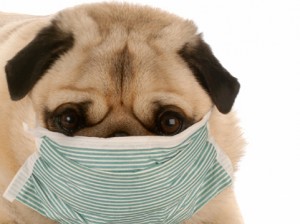Coronavirus and Dogs
Westminster 2020 was a standout show, one of the strongest finals I’ve seen in years. Siba was gorgeous, it didn’t snow, and all things considered the week went great…except for one thing. I literally couldn’t turn around without slamming into another barrage of misinformation about coronavirus. I’m not going to reiterate the claptrap here, especially since dog people should know better. We are no strangers to viral contagion, rabies, distemper, parvo, AND corona. We are well-informed about these omnipresent threats. End of story, right? NOT!
In the interest of curtailing some of the bizarre rumors, here’s a brief rundown of actual, verified facts about COVID-19.
First reported in Wuhan on New Year’s Eve, which seems like a hundred years ago, we now know that this strain was previously identified in both snakes and bats.
FACT: Nobody is secretly at work cooking up fiendishly lethal new strains. Viruses are never static. They mutate constantly because, unlike more sophisticated life forms (and there’s no consensus as to whether they even qualify as a life form), they are structurally simple, made up of approximately 13,000 base pairs compared to the billions comprising earthworms or humans. And those bits and pieces endlessly drift and shift into new arrangements that usually wither and die immediately.
FACT: Only rarely does a new mutant viral strain survive to the point of causing disease. In the past 40 years, the advent of DNA and RNA sequencing has vastly improved our understanding of how strains recombine into new subtypes. And we know that it happens all the time. But only rarely does a mutated strain jump the species barrier, say from chickens to pigs. COVID-19, which originated in snakes or bats, subsequently mutated into a form that could infect humans.
FACT: Another genetic remix through an intermediary host is necessary for a virus to evolve into a human pathogen. Sketchy research so far available suggests that the mutated strain initially infected humans via inhalation or ingestion of biological materials through the preparation or consumption of raw or undercooked animals. In the case of COVID- the pangolin (a form of anteater) most likely provided the free ride; it’s an extremely endangered species that never belonged on anyone’s dinner table to begin with.
FACT: COVID-19 emerged in a live animal market thus confirming what had long been predicted. Dense, stressful environments provide ideal conditions for viruses to mutate quickly and creatively mingle genetic materials from multiple species. This perfect storm of pathogenic contagion has happened before and, as mentioned, does not require the machinations of any mad scientists. There is no evidence that dogs or dog meat played any role in this.
FACT: Although technology has made it faster and easier to identify emerging pathogens, steps one and two of this transmutation process are admittedly impossible to control. However the next phase- the critical one- is definitely avoidable. Do not eat pangolin meat, especially raw pangolin meat. It’s a good way to get a disease. More precisely, it’s a good way to combine human and mammalian segments of flu virus for maximum virulence and contagion and a potential pandemic. You might recall that SARS, back in 2002, started in bats and made that fateful leap to humans via the civet cat- another species that doesn’t belong in your mouth.
FACT: Most human diseases originated in other species, ranging from TB to the common cold. But once they make that jump, they stay there. For example, there are myriad subtypes of morbillivirus, including one that causes measles in humans, and another one responsible for distemper in dogs. However, these strains do not/cannot switch back and forth. This is not a two-way street. You can’t catch distemper or give measles to your dog. Most importantly, highly effective vaccines render this discussion entirely theoretical.
FACT: The vast majority of viruses are species-specific, including flu viruses. We are most familiar with the H N flu strains. For instance, the avian H5 N1 flu virus mutated into the infamous Hong Kong flu. And a mutated H1 strain of swine flu caused the 1918 flu which still holds the record as the deadliest pandemic in human history. COVID-19 mutated into a form that is transmissible between humans. Animals, including dogs, cannot catch the human version.
FACT: Coronaviruses–first identified in the 1960s–are not new. Counting COVID-19, seven strains are known to infect humans. The most common types are 229E, NL63, OC43, and HKU1, The headliners are, of course, MERS and SARS, but they also spread more mundane pathogens like the common cold. There are also are subtypes of coronavirus that infect dogs, cats, and other species, but they are species-specific.
FACT: It’s good that you got your flu shot. Unfortunately, it won’t provide any immunity to this strain. Likewise, a flu shot won’t do your dog any good either. Virus strains are incredibly varied, which is why there’s a different flu vaccine every year. The longer any particular strain makes the rounds, the stronger natural immunity will become throughout the population. COVID-19 is dangerous because it is a new strain. No one has natural immunity.
FACT: There is no evidence that dogs transmit or catch COVID-19. At this point it is strictly a human problem. If your dogs are healthy and up to date on their vaccinations, stop worrying. Do not put surgical masks on them, spray their feet with bleach solutions, wipe them down with hand sanitizer, or any other weird, pointless stuff.
FACT: Anxiety compromises your immune system, and that actually will increase your chances of catching something, so relax.
So, there you go. The coronavirus is something we should all be aware of and, just like the flu, sinus infections, etc., the best defense for you is good hygiene. The good news is your dog won’t get it!
Short URL: https://caninechronicle.com/?p=179820
Comments are closed













